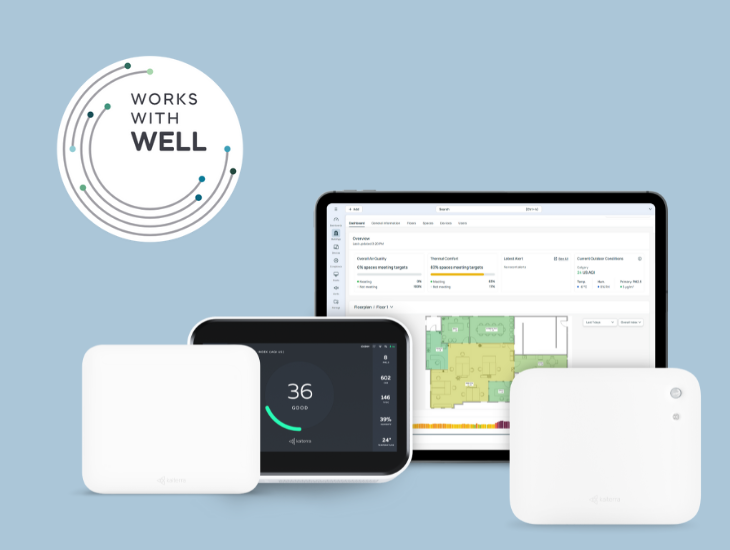Newsletter
Most of us have found ourselves working in buildings that felt freezing cold or unbearably hot. Arguments about the air conditioning are a staple of office life. But thermal comfort goes beyond individual preference, and can have serious implications on the health and wellbeing of building occupants. Managing temperature and humidity conditions is an important priority for organizations, as is office air quality monitoring.
In this article, we’ll review the key concepts you need to know about thermal comfort, including what it is and why it’s a concern for workplaces and employees. We’ll also look at strategies for continuous monitoring and improvement, and show how it ties into other indoor air quality (IAQ) and HVAC maintenance considerations.
What is Thermal Comfort?
Often mentioned alongside key parameters of air quality - particulate matter, carbon dioxide levels, indoor ozone and total volatile organic compounds (TVOC) - thermal comfort is a frequently overlooked factor that can deeply impact the health and psychological wellbeing of occupants.
Defined by the ISO as a ‘condition of mind which expresses satisfaction with the thermal environment’, thermal comfort is achieved when 80% of a building’s occupants are content with their temperature.
While surveys are sometimes used to determine thermal comfort, a model developed in the 1970s by Ole Fanger is still the primary method of predicting whether a person will be satisfied with the temperature of a given space, based on certain parameters. An individual’s thermal comfort is partly subjective and derives from both personal and environmental factors.
Read about the key air quality parameters that impact health and productivity:
- Understanding Total Volatile Organic Compounds (TVOC)
- Everything you need to know about Carbon Dioxide (CO2)
- A guide to particulate matter
- Why you should be monitoring indoor ozone
Environmental Factors Affecting Thermal Comfort
- Dry bulb temperature (DBT) or ambient air temperature: This metric is typically measured using a thermometer, and is not affected by moisture content. As most people share a core body temperature of roughly 98.6°F, the vast majority will find the same temperature ranges acceptable. For instance, the U.S. Occupational Safety and Health Administration (OSHA) recommends keeping office temperatures between 68°F and 76°F.
- Mean radiant temperature (MRT) measures the average temperatures of the surfaces surrounding a person in a given space, with which they exchange heat. In exterior settings, these can include the temperature of the sky and solar radiation. In an office, these surfaces are often walls, computers, windows or radiators.
- Relative Humidity (RH) is the ratio between the amount of moisture in the air, and the maximum amount of moisture the air can hold at that temperature. Higher levels of relative humidity make it more difficult to lose heat through perspiration, and can make the air feel muggy and unpleasant.
- Air velocity determines the rate at which heat is transferred between the air and adjacent surfaces, such as the body. The higher the velocity of the air, the higher the rate of heat transfer. As the temperature of the air is generally cooler than that of the human body, higher air velocities tend to feel colder.
Personal Factors
- Clothing acts as personal insulation and can account for disparities in thermal comfort throughout a building or workplace. Access to multiple layers of clothing allows a person to have greater control of their thermal comfort.
- Metabolic activity refers to the body’s accumulation and storage of energy. People with higher stationary metabolic rates tend to feel warmer than those whose rates are lower. Eating temporarily increases a person’s metabolic activity, leading to an increased temperature. For this reason, ready access to food is another way that occupants can control their thermal comfort.
How Does Thermal Comfort Relate to Health and Productivity?
Most people can recall disputes over the temperature of a shared work space. However, inadequate thermal comfort doesn’t just lead to staff conflicts, but can negatively impact physical and mental health, and reduce productivity.
(The Harvard T. H. Chan School for Public Health has recently proposed replacing the term thermal comfort with ‘thermal health’, to highlight outcomes such as illness and mortality that can result from neglecting these issues. Here are a few ways in which thermal comfort affects health and productivity.)
Studies have shown that inadequate temperature and humidity can lead to several negative outcomes:
- Lost productivity: A large body of research has confirmed the negative impact of overly hot and cold temperatures on performance and cognition. For example, a study carried out across five Tokyo office buildings showed that employees were far more willing to accept decreased illumination than increased heat, and self-estimated their productivity to be 6.6% lower when temperatures were increased. Another study of New York high school students showed that pass rates were 6.2% lower on 90°F days compared to 72°F days.
- Mold and fungal growth are more likely to spread when the environmental parameters associated with thermal comfort are not considered. Warm and humid environments, and those with poor ventilation, promote the ideal conditions for the growth of mold and other harmful fungi. Living or working around mold can cause respiratory problems, infections, allergies and asthma.
- Viral transmission can be accelerated when humidity and temperatures are too low. Airborne viruses, such as COVID-19 and influenza, die off more quickly in higher relative humidity, and shed for longer in colder temperatures. For this reason, it is important to strike the correct balance when monitoring and controlling these parameters.
Learn more about relative humidity and viral transmission here.
What Causes Poor Thermal Comfort? How Can You Address These Issues?
In order to prevent the harmful effects that poor thermal comfort can have on occupant health and wellbeing, and the complaints and resignations that can accompany them, it is important to be aware of their causes, as well as common solutions These can include:
Poorly maintained HVAC systems
In most office buildings, climate conditions are controlled by the HVAC systems, which both ventilate the space and heat or cool the air. These are extremely complex networks, where every part must be in order for the whole to function efficiently. One of these parts malfunctioning often causes poor thermal comfort, and other heating and ventilation issues.
For instance, a small leak in the air duct or refrigerant tank can prevent air from being properly dispersed throughout a building. Older systems may also be incompatible with current standards, or may be too large or small for the space they are supposed to ventilate.
The solution: Regularly monitoring the performance of your HVAC system is key, and will have the added benefit of ensuring a high level of indoor air quality in your buildings.
Using IAQ monitors can help you identify issues with the performance of your HVAC system - either through a rise in other harmful pollutants such as TVOC or CO2, or directly through readings of relative humidity and average temperature. Make sure to choose sensors that can continuously measure for all of these different parameters and give you clear visibility into them - we recommend Kaiterra’s enterprise IAQ monitors.
Temperature tyrants
Managers or other staff members might make decisions about the thermostat based on biased or incomplete information, and may dismiss employees complaints without due consideration. In many cases, the radiant temperatures surrounding an employee can be disregarded simply because the dry bulb temperature is judged to be within an acceptable range; it is important to remember that an individual’s temperature will be dictated by both factors.
The solution: Don’t leave decisions on temperature or air conditioning down to individual whim. Collecting data will help you take the subjective element out of the decision. It's also important to foster a culture of listening to employee concerns and adjusting the spaces where they work accordingly.
Window and door drafts, and radiant heat from windows
Doorways and windows can create situations when certain positions in an office are much colder than others.
The solution: While replacing windows can be prohibitively expensive and time consuming, adding a retrofitted solar film can block harmful UV rays and reduce radiant heat, while still allowing the light in. For drafts, a small, well placed heater can help to balance out an uneven heat distribution across even a large office or reception area.
Thermal Comfort Standards
Several organizations have created acceptable standards of thermal comfort, and other building health parameters, and can certify companies that uphold these standards. There are many advantages to being accredited by one of these organizations, such as attracting and retaining employees, investors, and clients, and promoting good health and well-being. Here are a couple of the most highly regarded standards organizations for building health.
- The WELL Building Standard is an international certification and standard designed to promote health-conscious buildings. One of the most highly regarded building standards, WELL certified companies include industry giants such as Goldman Sachs, Bloomberg, JP Morgan, and Uber. Thermal comfort is one of ten key areas that WELL have standardized as a key contributor to a healthy indoor environment.
Learn more about WELL certification - The ASHRAE Standard 55 specifies conditions for acceptable thermal environments.. As an American National Standard, the ASHRAE 55 is used extensively in North America. Outside the US, the ISO 7730 (Europe) and GB/T5701 (China) were developed in parallel with the ASHRAE 55.
Using IAQ Monitors to Improve Thermal Comfort
An IAQ monitor will collect temperature and relative humidity from the air, alongside key IAQ parameters. By having data, you can make decisions based on objective rather than subjective factors. This is especially the case if you have continuous readings that can show you trends over time, rather than a snapshot of how things were on a certain day.
In addition to changes in temperature and relative humidity, you'll be able to use air quality data to notice when your HVAC system is degrading. This will help you address issues early, and prevent issues such as mold or viral transmission - without having to wait for occupants to complain.
Finally, demand-controlled ventilation can reduce your energy costs and make your building more sustainable, helping to avoid more drastic steps to cut down on energy usage in the future.
Optimizing Temperature and Relative Humidity as Part of a Larger Workplace Wellbeing Strategy
We’ve seen that thermal comfort is affected by environmental factors such as temperature, humidity and air velocity, and personal ones such as clothing and metabolic rate. Neglecting these elements can have negative outcomes for the health, well-being, and productivity of building occupants. Organizations can gain the trust of investors, clients, and staff by becoming certified in thermal comfort standards such as the WELL Building Standard and ASHRAE 55.
Aging HVAC systems, inefficient thermostat use, and drafty offices are leading causes of poor thermal comfort. Monitoring temperature and relative humidity, along with other key air quality parameters, can provide the data needed to continuously monitor and improve thermal comfort, as well as reduce energy usage.
Interested in improving your workplace experience through healthy building optimizations?
- Download our comprehensive ebook on IAQ for Healthy Workplaces
- Read about how to choose a commercial air quality monitor
To learn more about how IAQ monitoring can help with thermal comfort in your built environment, schedule a free consultation with a Kaiterra air expert below:






.png?width=200&height=148&name=Menu%20C%20(2).png)

.png?width=307&height=228&name=Menu%20-%20D%20(1).png)
.png)




